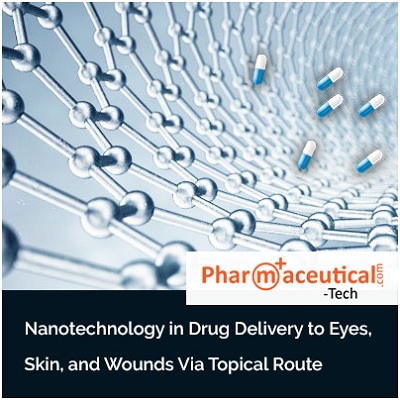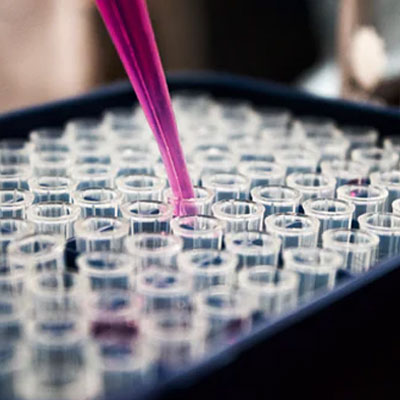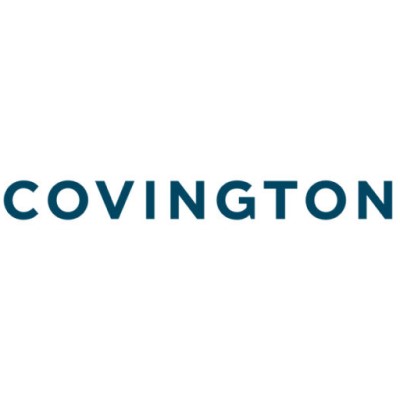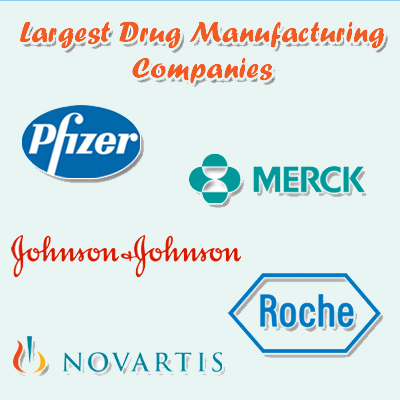Nanotechnology in Drug Delivery to Eyes, Skin, and Wounds Via Topical Route

One of the most favored courses for administering medications to eyes, skin, and wounds is the topical route. The principle objective for this is to arrive at enhanced efficacy and improve patient compliance. As the topical administration of drugs through conventional dosage structures, for example, solutions, creams, etc to the eyes is related to the low bioavailability (under 5%), and consequently, we can't rely upon these for conveying medications to eyes all the more productively. Notwithstanding, there's another famous medication delivery regime - intravitreal infusion, however is related to complexities like intravitreal discharge, cataracts, retinal separation, and endophthalmitis.
The skin has an intricate structure that fills in as various physiological obstructions to the section of exogenous substances. A significant part of some dermal illnesses is drug localization, that requires directed delivery of the active substance to the ailing cells, which is trying with current methodologies. The current treatments utilized for wound healing are expensive, and include durable medicines with 70% repeat possibility of ulcers. So, for designing formulations that would improve the effectiveness of conveying drugs through the skin course, nanotechnology - a novel and high potential innovation could be the correct answer. In this article, we would present to you a discussion on how nanotechnology-driven drug delivery systems have evolved, and their potential in overcoming the natural barriers for delivering drugs to eyes, skin, and wounds.
By giving possibilities to sustained drug discharge, enhanced localized effects by overcoming the normal hindrances, and decrease in toxicity; the headway in nanotechnology has made ready for topical drug delivery. Analysts have been working constantly on various nanotechnology-driven drug delivery frameworks, for example, liposomes, dendrimers, strong lipid nanoparticles, nanostructured lipid transporters (NLC), micelles, nano-crystals, and nanoemulsions. In any case, the significant difficulties in the improvement of nanotechnology-driven products are toxicity, clinical execution, low stacking limit, dependability scale-up, and reproducibility.
Delivering drugs to eyes stay a test, as the human eye is an anatomically mind-boggling structure. To arrive at the targeted ocular site, the drugs applied onto the eye either must be held at the cornea as well as conjunctiva or need to cross these hindrances to arrive at the targeted ocular site. The drugs need to diffuse through a gel-like, thick framework called the vitreous humor for treating sicknesses related to the rear of the eye. Because of its non-obtrusive nature with insignificant reactions, the topical route is the most favored course for conveying drugs to eyes. Be that as it may, it has been seen that there's an ocular bioavailability of under 5% with the regular topical drug delivery frameworks because of waste in the eyes, squinting, and fast tear turnover.
With stratum corneum as a significant blockade, the skin is the primary line of defence of the human body against the passage of exogenous chemicals and microorganisms. For a drug molecule to enter the skin surface, there could be two diffusional routes - transappendageal and transepidermal route. The transappendageal route incorporates transport through the perspiration organs and hair follicles, though the transepidermal course includes two fundamental pathways - transcellular and intercellular. Besides, to improve the infiltration of drugs through the skin, a few techniques have been utilized, for example, penetration enhancers, iontophoresis, prodrugs, nanotechnology-based drug delivery systems, and magnetophoresis.
However, because of the remarkable qualities and little size of nanotechnology-based drug delivery systems, these particularly may offer proficient, site explicit, and controlled delivery of drugs using the topical route.
Factors, for example, age, incessant diseases, for example, diabetes, smoking, obesity, blood vessel, and venous inadequacy are factors known to defer wound recuperating and increment the danger of developing wounds. These continuous injuries are a difficult clinical issue internationally. According to reports, the old populace is more inclined to interminable wounds. Stages like proliferative, rebuilding, incendiary, that happen consecutively are engaged with the wound recuperating process. The ceaseless wounds neglect to experience these successive stages, bringing about postponed wound healing. The current treatments for wound recuperating, for example, tissue designed skin substitutes are expensive, and a repetitive administration system is vital for the recuperation of patients just as they would be at a high possibility of ulcer repeat. Along these lines, there's a need to create novel drug delivery systems for sustained drug discharge at the injury site, which are additionally fit for lessening the repeat of ulcers.
I) Nanotechnology in Drug Delivery to Eyes
The anatomical structure of the eye comprises two parts i.e. anterior segment and posterior segment. While the two routes of penetration of drugs into the corneal epithelium are - paracellular and transcellular. The entry of lipophilic particles transcendently includes transcellular mechanisms, be that as it may, hydrophilic molecules and ions include the paracellular route.
Barriers for Topical Drug Delivery to Eyes
The anatomical structure of the human eye is very complex, making ocular drug delivery a challenge for formulation scientists. Several physiological barriers restrict drug delivery into the anterior and posterior segments of the eyes. The drugs have to be retained at the conjunctiva or cornea or may have to reach the inner structures of the eye depending on the site of pathology. The drugs entering the conjunctiva usually undergo systemic absorption, which leaves the cornea as a sole route for delivering drugs to the inner parts of the eye. A gel-like structure known as vitreous humor poses a difficulty for the drugs to pass through, thus obstructing the attainment of the optimum amount of drugs to the posterior segment. Hence, to reach the target site, there's a need to design drug delivery systems that help drugs in overcoming these barriers.
Nanotechnology in Overcoming the Barriers of Topical Delivery to the Eye
Due to the complex structure and physiology of the eye, the delivery of drugs into ocular tissues is one of the most interesting and challenging aspects to formulators. Nanotechnology over the most recent couple of decades has indicated promising outcomes in the management of ocular diseases through limiting eye aggravation, improving drug bioavailability as well as ocular tissue compatibility, acknowledging controlled drug discharge. A few nanosystems with explicit structures are accessible to convey their payloads in both the front and back portions of the eye.
Nanoparticles can be intended to beat the retinal barriers, including the blood-retinal barrier, contingent upon the particle charge, relative hydrophobicity, and surface qualities. Furthermore, nanosystems can give protection to the drug from debasement and can discharge the embodied drug in a continued and controlled manner. Nanoparticles prepared using common polymers like albumin exhibit promising results for ailment conditions like constant cytomegalovirus retinitis (CMV). Nanotechnology-intervened ophthalmic items are prodding colossal enthusiasm for retinal drug delivery since neovascularization and choroidal neovascularization have a comparative situation as strong tumors, where improved pervasion and maintenance (EPR) impact is assuming a job for chorodial neovascularization and drug targeting utilizing nanoparticles.
Kinds of Nanotechnology-driven drug delivery carriers for topical delivery to eyes
• Liposomes
• Niosomes
• Nanoparticles
• Polymeric Micelles
• Dendrimers
• Nano-implants
II) Nanotechnology in Drug Delivery to Skin
The skin has a mind-boggling structure that fills in as a physical obstruction to the passage of exogenous substances. Skin is made out of three unmistakable layers, i.e., epidermis, dermis, and hypodermis. For effective drug transport through the skin, the nearness of various physiological obstructions presents difficulties to the pharmaceutical scientists.
Barriers for Topical Drug Delivery to Skin
The stratum corneum goes about as a significant barrier in conveying drugs to the skin, particularly for hydrophilic and bigger drug molecules. Inserted in a lamellar structure, the stratum corneum of skin comprises of corneocytes. The one of a kind plan of the corneocytes is the fundamental explanation behind this layer to oppose the pervasion of molecules through it. The two main considerations that influence the penetration are hydration and skin temperature.
Conventional Topical Delivery Systems in Treating Skin Diseases
Providing local and directed delivery to the infected skin cells is the fundamental goal of delivering drugs topically for skin ailments. The directed delivery of the drugs decreases the unfriendly impacts that may some way or another happen when the drug is conveyed deliberately. The treatment of chronic skin illnesses, for example, atopic dermatitis, psoriasis, and skin inflammation need long haul utilization of topical medication. Topical drug delivery systems are the favored delivery systems in such conditions and can be utilized to treat skin contaminations, for example, bacterial (impetigo, cellulitis), parasitic (sporotrichosis, blastomycosis, and chronomycosis), viral (dermatitis, herpes simplex virus) and autoimmune diseases (psoriasis, scleroderma). The main disadvantages, for example, fluctuation in flux, repetitive dosing, limit them from being considered as effective topical products. Other than these, the hypersensitive responses, which make them less sheltered is another downside related to conventional drug delivery systems.
Nanotechnology in Overcoming the Barriers of Topical Delivery to the Skin
To unravel the different difficulties connected with conventional systems, the novel drug delivery are being contemplated, predominantly through improvement of the entrance of drugs through the skin. Providing controlled drug release, which diminishes the continuous utilization of medicament and lessens the unwanted symptoms, just as ensuring the debasement of encapsulated drugs is the principle point with the novel systems.
Nanotechnology-driven drug delivery systems help in site-explicit skin targeting, which may bring about more prominent drug retention at the target site. The epithelial cells of skin have a negative charge on their surface because of which it's foreseen that the drug delivery systems conveying positive charge can without much of a stretch interact with the cells, prompting delayed pharmacological impact and an increased permeability of the drug.
Kinds of Nanotechnology-driven drug delivery carriers for topical delivery to eyes
• Liposomes
• Solid Lipid Nanoparticles
• Niosomes
• Nanoparticles
• Polymeric Micelles
III) Wounds and the Barriers for Topical Drug Delivery to Wounds
The wounds can be classified depending on the microbial load, nature of healing, thickness, whereas acute or chronic wounds are based on the nature of healing. The wound healing time is 8-12 weeks in acute wounds, while in chronic wounds, the anatomical and functional integrity of the skin is not restored for three months. Chronic wounds include diabetic foot ulcers, pressure ulcers, and vascular ulcers. Based on the thickness of the wound, they can be classified as partial, superficial, and based on their microbial load, full thickness wounds can be classified further as clean, contaminated, clean-contaminated, and infected wounds.
Endogenous components are valuable for wound recuperating clinically, yet their clinical use is confined because of their breakdown by the proteolytic compounds that are available at the injury site. The injury condition has a few favorable to incendiary cytokines that can deactivate drugs. The topical use of development factors for wound healing is restricted and blood stream is likewise poor at the site of wound recuperating. Subsequently, systemic drug delivery is additionally not of critical significance in wound recuperating. In this way, the injury condition requires complex drug delivery systems that can convey the drugs and growth factors to the proper site.
The Wound Healing Process
A mind boggling occasion that is intended to reestablish the ordinary functions of the skin and diminish the danger of contamination and further difficulties is wound healing. A few elements are related with poor wound healing, yet the significant job has been played by an unusual and predictable fiery reaction, which prompts an over the top proteolytic action because of the proteolytic catalyst debasement bringing about aggravation intervened tissue harm. Also, the diminished blood supply to the injuries prompts ulcer formation. Hemostasis, irritation, proliferation, and rebuilding are the four stages in wound mending.
Kinds of Nanotechnology-driven drug delivery carriers for topical delivery to wounds
• Nanoparticles
• Solid Lipid Nanoparticles and Nanostructured Lipid Carriers
• Liposomes
• Nano Implants
Toxicological Aspects of Topically Applied Nanoformulations
For any topical formulation, toxicity is a prime concern and the establishment of a toxicity profile is an obligatory necessity for regulatory approval. Nanoparticles can enter the cells and can create free radicals, which prompts oxidative stress and collagen depletion (which incorporates keratinization, decay of the dermis and skin wrinkling). The different basic quality properties including the polymer fixation, critical process parameters of the topical formulation, drug characteristic can prompt surprising contrasts regarding wellbeing, viability, dependability, and toxicity. A few reports are accessible referencing the benefits of nanotechnology-based dermal plans yet their harmfulness appraisals are scant, but its outstanding centrality in clinical interpretation.
Conclusion :-
Nano-based systems unquestionably exhibit an improvement in wellbeing and viability for topical drug delivery and hold extraordinary potential for proficient treatment prompting improved nature of the patient's life.



